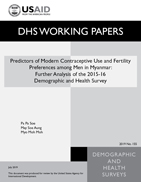- PUBLICATIONS
- JOURNAL ARTICLES
- ACCESS PUBLICATIONS
Publications Summary
- Document Type
- Working Papers
- Publication Topic(s)
- Family Planning, Fertility and Fertility Preferences, Gender
- Country(s)
- Myanmar
- Language
- English
- Recommended Citation
- Soe, Pa Pa, May Soe Aung, and Myo Moh Moh. 2019. Predictors of Modern Contraceptive Use and Fertility Preferences among Men in Myanmar: Further Analysis of the 2015-16 Demographic and Health Survey. DHS Working Paper No. 155. Rockville, Maryland, USA: ICF.
- Download Citation
- RIS format / Text format / Endnote format
- Publication Date
- July 2019
- Publication ID
- WP155
Download
 Predictors of Modern Contraceptive Use and Fertility Preferences among Men in Myanmar: Further Analysis of the 2015-16 Demographic and Health Survey (PDF, 409K)
Predictors of Modern Contraceptive Use and Fertility Preferences among Men in Myanmar: Further Analysis of the 2015-16 Demographic and Health Survey (PDF, 409K)
